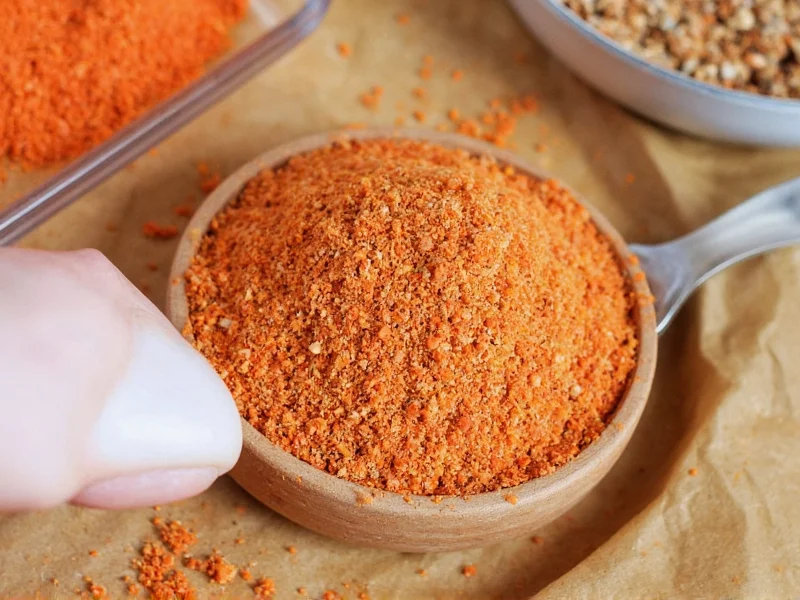Understanding Rub Seasoning Fundamentals
Rub seasoning represents one of the most effective dry preparation methods for enhancing meat flavor and texture. Professional chefs and backyard grill masters alike rely on properly formulated rubs to transform ordinary cuts into extraordinary dishes. The magic happens through direct contact between the dry ingredients and meat surface, creating that coveted crust while allowing smoke penetration during cooking.
Dry Rub vs. Marinade: Key Differences
Many home cooks confuse rubs with marinades, but they serve distinctly different purposes. While marinades are liquid-based and work through acid tenderization, rubs are completely dry formulations that:
- Create immediate surface flavor without moisture interference
- Promote better browning and crust formation
- Don't require extended preparation time
- Maintain meat's natural texture without enzymatic breakdown
| Characteristic | Dry Rub | Marinade |
|---|---|---|
| Moisture Content | Dry ingredients only | Liquid-based |
| Application Time | 30 minutes to 24 hours | 2-24 hours |
| Primary Function | Flavor crust development | Tenderization + flavor |
| Best For | Grilling, smoking, roasting | Grilling, broiling |
The Science Behind Effective Rub Formulations
Successful rub seasoning follows specific chemical principles. The salt content (typically 15-20% of total weight) serves multiple functions beyond simple seasoning. It draws out meat proteins that then bond with the rub ingredients, creating that signature bark. Sugar components (8-12%) facilitate caramelization and the Maillard reaction, while spices provide aromatic complexity.
Timing matters significantly when applying rub seasoning. For optimal smoke ring development and flavor penetration, apply your rub at least 45 minutes before cooking. This allows time for the salt to begin its osmotic process without creating a paste-like consistency that would inhibit proper searing.
Essential Components of Professional-Quality Rubs
All effective rub seasoning contains these fundamental elements in proper balance:
Salt Foundation
Kosher salt forms the essential base of any quality rub, typically comprising 15-20% of the total mixture. This precise ratio ensures proper flavor enhancement without overwhelming the palate. The salt crystals' structure allows for even distribution and optimal meat interaction.
Sugar Elements
Brown sugar, white sugar, or alternative sweeteners (3-12%) provide necessary caramelization points. Darker sugars create deeper color and richer flavor, while white sugar produces cleaner searing. The sugar-to-salt ratio dramatically affects the final crust texture and appearance.
Spice Profile
Ground spices like paprika, garlic powder, onion powder, and cumin form the flavor backbone. Freshly ground whole spices generally produce superior results compared to pre-ground commercial blends. The particle size significantly impacts how the rub adheres to and penetrates the meat surface.
Application Techniques for Maximum Flavor
Proper rub seasoning application follows specific methodology. First, pat your meat completely dry - moisture is the enemy of proper rub adhesion. Then, apply the rub generously using a gentle pressing motion rather than simply sprinkling. This 'massaging' technique helps the particles adhere and begin the flavor infusion process immediately.
For larger cuts like brisket or pork shoulder, consider the 'Texas crutch' approach - applying the rub, refrigerating uncovered for several hours, then applying a second light coat just before cooking. This double application technique creates exceptional bark development while maintaining moisture balance.
Avoiding Common Rub Seasoning Mistakes
Even experienced cooks make critical errors with rub seasoning that compromise results:
- Over-salting: Exceeding 20% salt content draws out too much moisture
- Applying too late: Less than 30 minutes before cooking prevents proper adhesion
- Mixing wet ingredients: Adding liquids creates a paste that steams rather than sears
- Ignoring meat temperature: Applying rub to frozen meat prevents proper absorption
Creating Custom Rub Formulations
Developing your signature rub seasoning follows a simple framework. Start with the 4-3-2-1 ratio: 4 parts salt, 3 parts sugar, 2 parts primary spice (like paprika), and 1 part accent spices. From this foundation, adjust ratios based on your cooking method and meat type.
For example, when creating a rub seasoning for steak, increase black pepper and reduce sugar content compared to a pork rub. Chicken benefits from additional herbs like thyme and rosemary, while fish requires delicate handling with minimal salt and no overpowering spices.
Storage and Freshness Considerations
Homemade rub seasoning maintains peak flavor for 2-3 months when stored properly in airtight containers away from light and heat. Commercial blends often contain anti-caking agents that extend shelf life but may compromise flavor purity. For best results, grind whole spices yourself and mix in small batches to ensure maximum aromatic intensity.
FAQ: Rub Seasoning Essentials
How long should rub seasoning stay on meat before cooking?
For optimal results, apply rub seasoning at least 45 minutes before cooking. This allows sufficient time for salt to begin interacting with the meat surface without creating excess moisture. For larger cuts like brisket, refrigerating uncovered with the rub for 4-12 hours produces exceptional bark development while maintaining proper moisture balance.
What's the ideal salt percentage in homemade rub seasoning?
Professional rub formulations typically contain 15-20% salt by weight. This precise ratio ensures proper flavor enhancement and surface interaction without overwhelming the palate or drawing out excessive moisture. Using kosher salt rather than table salt provides better crystal structure for even distribution and optimal meat interaction.
Can you use rub seasoning on vegetables?
Yes, but with significant adjustments. Vegetable rubs should contain 30-50% less salt than meat rubs and avoid ingredients that require high-heat caramelization. Root vegetables particularly benefit from rubs containing smoked paprika and garlic powder, while delicate vegetables work better with herb-focused blends. Always apply vegetable rubs immediately before cooking to prevent moisture loss.
Why does my rub seasoning fall off during cooking?
Rub seasoning falls off primarily due to improper application technique or moisture issues. Ensure meat surface is completely dry before application, use a gentle pressing motion rather than sprinkling, and allow at least 30 minutes for the rub to adhere before cooking. Excess sugar content (over 12%) can also cause rubs to burn and detach prematurely during high-heat cooking.











 浙公网安备
33010002000092号
浙公网安备
33010002000092号 浙B2-20120091-4
浙B2-20120091-4